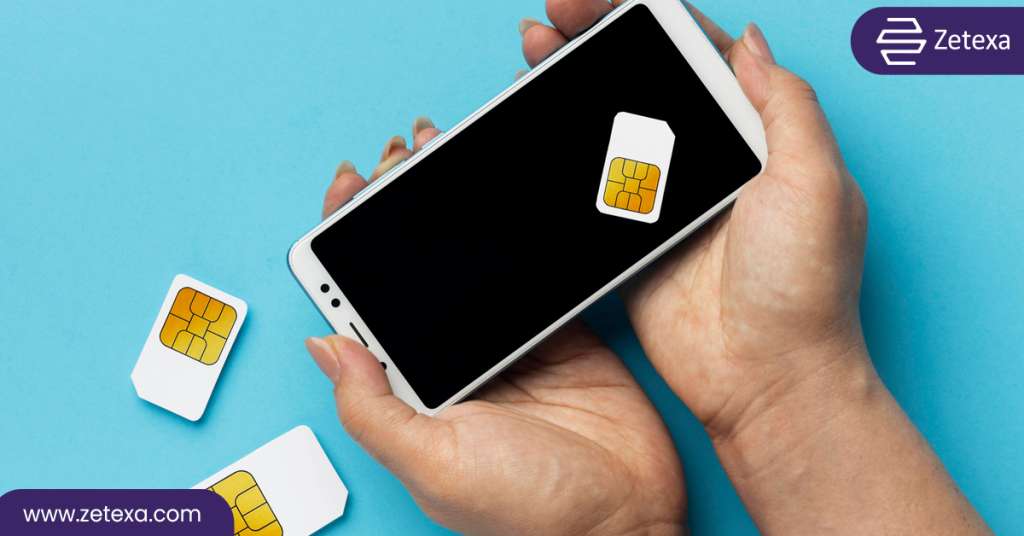It is a new paradigm of connecting to a mobile network as the traditional SIM is made to be physical, whereas in the case of an eSIM, it is digital. In other words, there’s nothing one would call insertion in this case, as changing from one carrier to another is pretty convenient. This innovation therefore opens new vistas into mobile communications, IoT, and global connectivity making eSIM an integral component of the future of telecom.
What is an eSIM?
An eSIM is simply called embedded Universal Integrated Circuit Card or eUICC. This microchip is placed inside the hardware of a device and accommodates multiple carrier profiles. That means a user can easily swap between numerous profiles. The procedures by which one activates and controls the carrier profiles are known as Remote SIM Provisioning or RSP.
The other advantages that eSIM technology has over the traditional type include;
The physical SIM card slot can be eliminated; hence, the makers will be able to come up with slim devices and streamlined.
This technology has enabled one device to incorporate different carrier profiles. In that context, the device happens to be very convenient in respect of traveling professionals as well as enterprises.
It supports remote provisioning. This makes it easier to change carriers or activate plans without necessarily requiring any form of physical intervention.
How Does eSIM Work?
These few key components form the whole crux of eSIM, and each is fundamentally indispensable for its operation. So,
1. Remote SIM Provisioning (RSP): The Core Process
It refers to the system via which carriers remotely manage and provision profiles on devices that carry an eSIM installed in them. There are three pillars that RSP operates on: these are:
SM-DP+ (Subscription Manager – Data Preparation+): the server where the carrier keeps and prepares eSIM profiles to download safely to the device.
SM-DS (Subscription Manager – Discovery Server): Central directory that allows a device to locate the right SM-DP+ server to download the profile.
LPA (Local Profile Assistant): The software associated with the device that executes all the operations regarding eSIM profiles, including installation, activation, and deletion.
2. The Physical Component: eUICC
The eUICC is the hardware module on devices, and it is a digital SIM. It is also GSMA interoperable and secure with other devices and carriers.

3. The eSIM Profile
An eSIM profile keeps all the data that connects a device to a mobile network. Its main constituents are as follows:
IMSI (International Mobile Subscriber Identity): This is the identity that the network uses to uniquely identify the subscriber.
This is the ICCID for an eSIM profile that may be used during authentication and identification to a network.
This is Carrier configuration data with APN, APN, as well as others that may be set in place for providing access into the network, security credentials which feature encryption keys together with identifiers: such as identification Key denoted as KI together with the operator code, OP; hence providing safety with regard to communications.
Evolution of eSIM Technology
The GSMA eSIM V1 Standard
eSIM technology gained seriousness in 2016 when the Global System for Mobile Communications Association had already released the eSIM V1 standard. It offered a global framework for implementing the eSIMs operating on cross-device, cross-carriers, and cross-region interoperability.
Some of the major milestones that eSIMs had to undergo in their development process are:
Early Adoption to Wearables 2017: The first consumer devices for which eSIM technology were announced were the smartwatches and other such fitness tracking wearables like Apple Watch and Samsung Gear.
Deployment to Smartphones 2018: Firms like Apple and Google started offering eSIM for its high-end smartphones that came with iPhone XS and Pixel 3.
IoT Revolution (2020 Onwards): eSIM has emerged as a critical technology to enable IoT applications and scenarios in automotive, health, and agriculture sectors.
International Trends
Adoption happens quickly, everywhere. Today eSIM is supported by all key global carriers and built-in many devices from top manufacturers on smartphones, laptops, tablets and other wearable devices.
The IoT segment has been particularly embraced by eSIM, because it allows manufacturers to distribute devices across the globe without country-specific SIM configurations. Connected cars, smart home appliances, and industrial sensors all use eSIM to enable easy, scalable connectivity.
Benefits of eSIM Technology
The benefits of eSIM technology are changing both consumer and enterprise markets:
1. Increased Convenience
No Physical SIM Cards. In this way, customers may switch between service providers by simply choosing a few options from the mobile phone.
The multiple carrier configurations that they store in profiles make perfect usage for any mobile application user. Those users of multiples lines or frequent travelers will save hundreds because they would not need to carry around the separate handsets’ SIM cards with themselves.
2. Economical Design
Save that space and let manufacturers use the smaller size water resistant models.
3. Cost Benefit to travelers
eSIMs eliminate the expensive roaming plans as users can switch to local carriers or global data plans.
4. Scalability for IoT Applications
eSIM technology makes it easier to have global deployment of IoT devices with remote provisioning and management.
5. Environmental Benefits
eSIMs reduce reliance on physical SIM cards, thus reducing plastic waste and carbon footprints.
Challenges and Opportunities
- Despite many developments in eSIM technology, there are still challenges that need to be addressed:
- Limited carrier support: eSIM technology does not have the support of all carriers around the world.
- Provisioning: While carrier and device provisioning processes remain mostly unstandardized regarding seamless provisioning between the carrier and the device.
- Security: This will call for robust encryption and authentication technologies to safeguard the eSIM profiles against unauthorized access.
- This will also be a place of pioneering innovators such as Zetexa at the forefront of easy-to-use, secure, and universally compatible eSIM solutions.
Zetexa: The Innovation Leader in eSIM Revolution
As eSIMs gain in pace, Zetexa will be the one to make the difference with its cutting-edge solutions. Here is how Zetexa marks a new benchmark in the eSIM landscape:

1. Holistic connectivity solution
Zetexa has an assortment of products that cut across physical SIM, magic SIM, and eSIM. Functionally, the product supports users connect everywhere in the world on 4G-5G networks without outages.
2. People-focused
Activation of an eSIM from Zetexa could go as simple as scanning QR. Its user interface keeps processes smooth for individual users as well as businesses and firms.
3. Affordability
Travelers avoid inflated roaming charges as with the low-cost international plans available in Zetexa. IoT business operations get deployable price offers for implementations.
4. Security Innovative
Zetexa eSIM uses the most modern encryption and authentication of customers’ data and is thus a way of safe communication.
5. Facilitating Future IoT Development
Zetexa develops complex applications of eSIM into IoT, making reliable connectivity for smart machines operating in the industries of automotive, health care, logistics, among others.
6. International Cooperation
Zetexa is extending the eSIM ecosystem through collaboration with leading telecom operators, device manufacturers and IoT providers, driving innovation.
Future of eSIM Technology
The eSIM market will expand exponentially in the next few years. According to industry reports, the global eSIM market size is projected to rise to $16 billion by 2030, led by increased adoption in consumer electronics and IoT.
Key Trends to Watch
- Full Transition to eSIM: The physical SIM card will be out of date in the next decade as more and more carriers start supporting eSIM technology.
- IoT Explosion: eSIM is going to be the number one scaling technology for all connected scenarios, from smart cars to smart cities.
- 5G Integration: The 5G networks are going to make eSIM much stronger and more potent. It is going to provide fast pace along with reliability connectivity.
It’s a first in terms of capitalizing on such a trend. Inventing in R&D and strategic partnerships with users being their top priority, Zetexa is molding the future of eSIM technology.
Conclusion
It is much more than a technological innovation – it is the revolution in the way of connecting, communicating, and relating to the world. Almost everything can be said about eSIM technology, from making mobile connectivity simple to opening the floodgates of the IoT revolution.
As a market leader, Zetexa is going to define the standards in terms of innovation, security, and user experience regarding eSIM. From roaming connectivity for the globe-trotting tourist to the deployment of an IoT device for enterprise, Zetexa’s eSIM technology will make all that possible- always connected and everywhere.
The future of connectivity now arrives: from Zetexa.

Download ZetSIM App from the APP Store
Download ZetSIM App from the Google Play Store
FAQs
An eSIM (embedded SIM) is a digital SIM that allows you to activate a cellular plan without a physical SIM card.
Unlike physical SIMs, an eSIM is built into the device, enabling users to switch carriers instantly and store multiple network profiles.
Many smartphones (iPhone, Samsung, Google Pixel), tablets (iPads), and smartwatches now support eSIM technology.
Instant activation via QR code
No need to swap physical SIMs
Cost-effective international roaming
Reliable high-speed connectivity
Zetexa eSIM offers affordable, seamless global connectivity, eliminating the hassle of buying local SIM cards.



